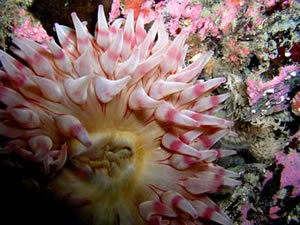
 |
|
|
Artificial reefs installed north of JuneauDecember 27, 2007NOAA press release: State and federal agencies and the University of Alaska Fairbanks cooperated to build two artificial reefs made of stone in the waters of Lynn Canal, 18 to 25 feet down. The experimental project is designed to enhance near-shore marine habitat for fish and invertebrates.  An anemone and warbonnet in Yankee Cove. Both species will likely use the new reefs. "The final rock was placed the night of December 20th" said NOAA Fisheries Alaska Regional Administrator Jim Balsiger. "Rigorous study and monitoring will allow NOAA Fisheries and University of Alaska scientists to determine if the materials and design are enhancing marine habitat as expected." The two new reefs lie just offshore of Adlersheim Lodge north of Juneau. One is located inside Yankee Cove and the other immediately outside the peninsula protecting the cove. NOAA Fisheries initiated the project through discussions with the Alaska Department of Transportation, reviewed the research proposal and obtained all required state and federal permits. The University of Alaska Fairbanks designed the project and study plan and completed extensive surveys of the seafloor and existing local rocky reefs. The Alaska Department of Transportation and the Federal Highway Administration provided engineering expertise, funding, and contracting services for the project as partial mitigation for the planned Juneau Access Improvement Project. The Army Corps of Engineers has not yet issued a permit for the proposed road, but the transportation agencies decided to proceed with the habitat enhancement in advance. "They are the first artificial reefs in southeast Alaska built of local, natural materials," said NOAA Fisheries Marine Resources Specialist Sue Walker, who developed the project in cooperation with the other organizations. NOAA Fisheries worked with partners in 2006 and 2007 to place manmade artificial reefs to enhance habitat in Shotgun Cove near Whittier, Alaska. Local groups facilitated sinking vessels north of Auke Bay in 2003 for recreational diving opportunities, but not for fish habitat. The Lynn Canal reefs are two flat-topped structures made of angular quarry rock two layers thick with a maximum height of about six feet, Walker said. The two structures, each 30 feet wide by 100 feet long, were placed on sandy bottom and incorporate about 30% open space between the rocks to provide habitat for fish and marine invertebrates such as juvenile rockfish, shrimp and eels. The depth and design are intended to support the settling and growth of kelp and other seaweeds that provide ideal spawning habitat for Pacific herring. University of Alaska Fairbanks graduate student and diver Daniel Okamoto completed extensive baseline research before the reef was installed. Okamoto is advised by University professors Dr. Ginny Eckert, a marine ecologist, and Dr. Mike Stekoll, who has broad expertise in the study of marine algae. Okamoto and Eckert decided upon the Adlersheim site after completing dive surveys of other potentially suitable sites accessible via the Juneau road system. The site met all criteria for success including depth, topography, proximity to productive natural rocky reefs, accessibility, and low numbers of green sea urchins that could decimate kelp that researchers expect to grow on the new reef. Local contractor Trucano Construction built the reefs to specifications by placing rock at the site from a barge. Okamoto will conduct experiments and post-construction monitoring to assess colonization and use of the rock structures by fish, kelp and other seaweeds, marine invertebrates such as sea urchins, sea cucumbers, sea stars, nudibranchs, bryozoans, sponges, and the myriad of other animals that inhabit the underwater habitats of Lynn Canal. NOAA Fisheries research divers, including Walker, will continue less-frequent monitoring into the future to determine the long-term success of the project at enhancing marine habitat. © AlaskaReport. All Rights Reserved. |
Alaska Weather |